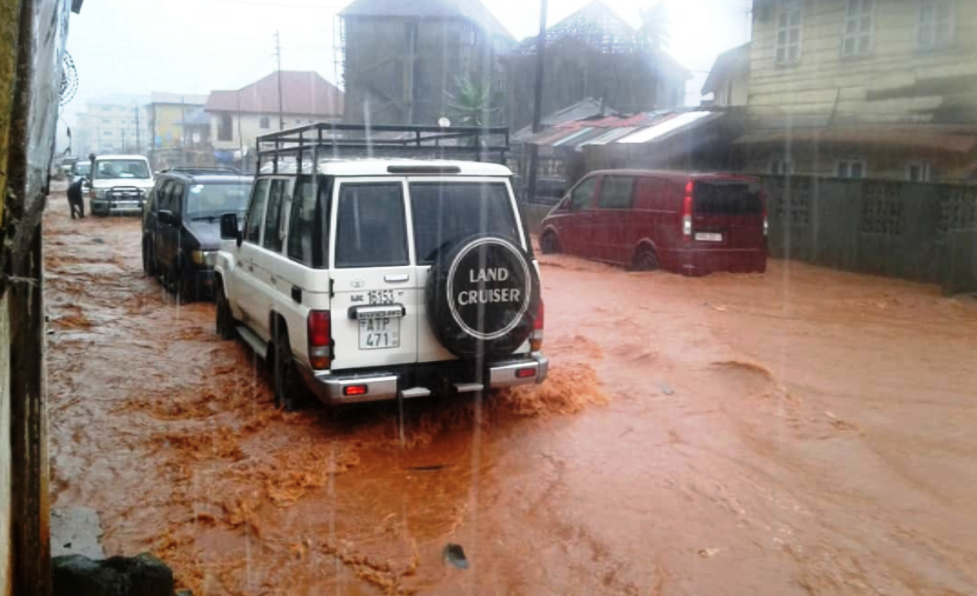By: Francis F. M. Harding
Evidence is clear that climate change is changing weather patterns, increasing the frequencies and intensities of extreme weather events. Unfortunately, those in the poorest communities are disproportionately affected. The human, socio-economic and environmental impacts of floods in Sierra Leone have seen a skyrocketing trend over the last decades. Between 1980 and 2017, floods affected approximately 221, 204 people, killing some 145 people.
On 24 June 2017, heavy downpour of rain flooded two towns of Largor Jasawabu in the Nongowa Chiefdom and Foindu Mameima in the Lower Bambara Chiefdom, near Kenema. Torrential rainfall in the month of August 2017 led to widespread flooding across different parts of Freetown City, including Karningo, Kamayama, Dwarzark, Kroo Bay, Congo Town, Kissy Brook, and Culvert community in Granville Brook. Is like a repeat of negative history. Freetown experienced two successive days of intense and heavy rainfall which has caused disaster, destruction of property and lived people homeless. A common threat to Freetown is the rapid rate of urbanization, coupled with the increased rate of deforestation. In fact, the area where the landslide occurred was within protected forestry reserve.
However, over time, development of large houses and occurred some illegally (without permits) some with permits (legally). Because of these two factors, housing development and deforestation, soil integrity was weakened and the ability to absorb rain during high rainfall and increased the risk of disaster. The country has been the very real impact of climate change in recent years including devastating flooding and landslides that claimed the lives of people.
Sierra Leone is ranked below the United Nations Human Development Index. In the Freetown municipality, significant factor in such disasters is the absence or low capacity of drainage systems exacerbated by the accumulation of waste and poor city planning. 21% of Freetown’s waste is estimated to be properly collected and disposed off leaving the rest roughly 550 tons per day to be indiscriminately burned or dumped in streets, waterways and illegal dumpsites. The waste management capacity of the authorities in Freetown is ineffective to meet the present and increasing needs, particularly for those in slums and hard to reach areas of the city. Freetown has two authorized waste disposal sites: the Kingtom in the west and the Granville Brook in the east. Both sites are already beyond maximum capacity and lack basic planning (weighing equipment, roads, and entrance regulation) or the staff to manage orderly and proper waste disposal.
The floods resulted in destruction of houses and road networks, and the livelihoods.
When Forum News visited several scenes of communities. At Spur Loop, N’jagelema Forum spoke with one of the victims, Hawa Kamanda. She said during the heavy pure rains the fence closed to their house fall and water entered into their house, created stagnant pools of water and temporary rain. She said that there were significant increase of water in their room and parlour. Hawa continues that they had sleepless night as they were removing water from their house and thanked God no life is lost. She called on government to come to their aid to tell the owner of the fence to erect proper fence retaining wall fence. Another victim two Fear Yambasu a lactating mother in the same community, narrated similar encounter saying her daughter’s box which contained her cloths and other valuable items were swept away by the water. She also called on authorities and humanitarian organizations for help.
The third victim this medium spoke to, David Lansana, said the rain came continuously and the fence at the Indians are staying with the pressured of the water the fence fell and the granite stone rolled down with the water and hit the zinc house and cleared it to ground level and all the things go. He said money was in his bag up till Five Hundred Leones, beds, cloths, pans, pots, and other valuable items. He said the owner of the fence should erect it with good retailing wall as the fence is a potential threat to them, especially who stay down Spur Loop.
Forum News tried to get the Indians’ side of the story but their security said they were asleep at the time in question. Explaining his ordeal, victim four, Shar Simbo said he was not asleep by at 3:00 am when he hear sound by the time. He said he tried to open the door to check, noting that the water has over powered the entire house and destroyed his property. Mammy Kebbie who is the fifth victim talked to at 38C Babadorie, said she went to use the bathroom upon returned she told her husband that the water has over powered the gate and entered their room and parlour, they wanted to come out but there was no way as the water has over powered the entire compound. Mammy Kebbie said; “But I risk it to carry my children to the nearby houses.”
She narrated that their timbers for sale which cost huge amount money were stolen by youth around community, whilst they relocated other household utensils to another compound for safety. At Wilkinson Road, it was blocked due to the heavy down pour which caused vehicular traffic. Other communities in Freetown that were badly affected by the flooding are Kroo Bay, Congo town, Wilkinson Road, Dundas Street etc.
Every year Sierra Leoneans will not learn about flooding, as if the rains do not comes with bodies being wash up on the beaches, destruction of properties, and bridges connecting communities and destroy water distributions networks.













